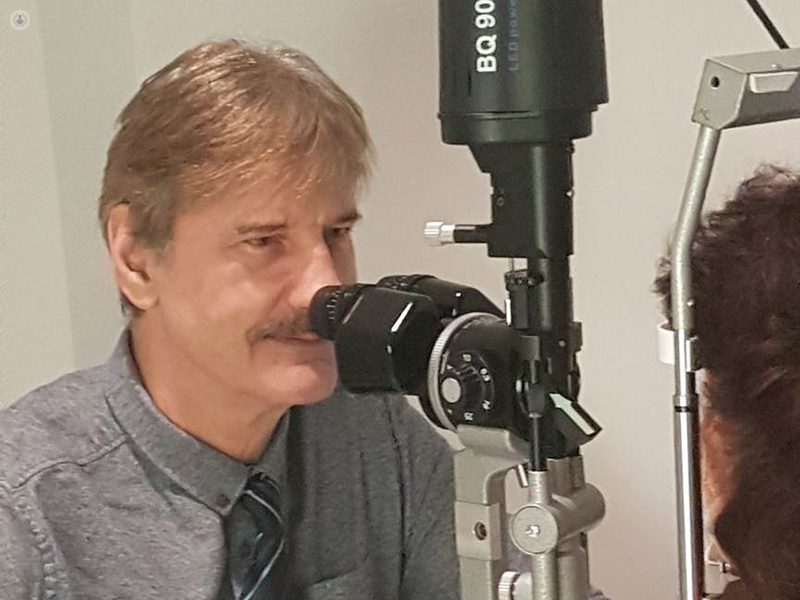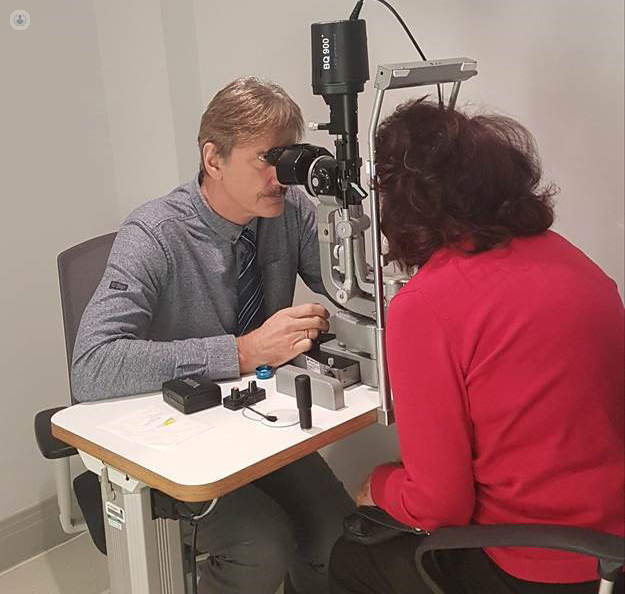Coping with Low Vision
Escrito por:Low vision is typically defined as a condition in which a person’s vision cannot be fully corrected by glasses and the level of vision is such that there is significant interference with performing daily activities such as reading and driving. More profound levels of visual loss may lead to further loss of independence, with difficulty preparing food and drink and even performing self-care tasks such as washing and dressing.
Ophthalmologist Mr Dominic McHugh talks about what causes low vision and what devices are available to help people with vision problems.

What causes low vision?
There are a number of causes of low vision. A treatable cause is cataracts and, after surgery, provided there are no other sight-threatening eye conditions present, a satisfactory visual improvement should be expected.
Other conditions such as diabetic retinopathy, macular degeneration and glaucoma are treatable but in some patients, despite treatment, unfortunately, there may be progressive visual loss.
What’s the difference between having low vision and blindness?
Although in common parlance the word “blindness” refers to the inability even to see light, medically there are grades of visual impairment before this stage is reached. A patient may be certified as being sight impaired (partially sighted) if only the top letter of a standard visual acuity testing chart can be read, with the better eye at 6 metres with a full field of vision.
If there is also constriction of the peripheral field (causing, for example, a patient to bump into people and objects on either side) then, even if the visual acuity is better (for example being able to see halfway down the chart) there may still be eligibility for partial sighted registration.
Registration for severe sight impairment (blindness) may be performed if the patient can only see the largest letter of a standard sight-testing chart at a reduced distance of 3 metres. Again, if there is significant visual field constriction, the patient may be eligible for registration for severe sight impairment.
In the United Kingdom, if a patient is registered as either sight impaired or severely sight impaired, they will be eligible for additional support and benefits. The RNIB provides helpful information on providing support for patients with visual impairment:
What low vision devices are out there to help?
In order to help with reading vision, there is a number of magnifiers that can be either placed on the printed page or worn on a spectacle frame. Spectacle-mounted telescopic aids also improve distance vision. Thanks to advances in technology, the widely available electronic readers (for example Kindle) as well as software such as Zoom Text provide greater ease of reading with font size enlargement.
Computers and electronic readers often have a text-to-speech facility, which many patients find more convenient than attempting to read directly. Many optometrists have an interest in patients with low vision and can provide helpful advice and low vision aids. Hospital-based ophthalmology departments usually have a low vision aid department to which patients can be referred by their ophthalmologist.

What would you recommend to help people with low vision so they can live more independently?
Home adaptations can be provided, for example, improvements in lighting, the elimination of uneven surfaces and the installation of additional handrails to prevent trips and falls. The use of electronic devices such as talking clocks and microwaves and liquid level detectors will also improve independence.
Low vision is not necessarily a bar to working. For example, a desk-based clerical job can be performed with the use of large screens, software adaptations to increase the font size of text and of course text-to-speech facilities. Measures can also be taken to make the environment safe for a person with low vision, for example with the removal of obstacles that may cause trips or falls.
Are there any key medical advances or new technologies that can help to assist people with low vision?
Although the surgical implantation of telescopes has been carried out, this is a major operation and the results are often disappointing. A patient with low vision wishing to consider this option should discuss this with a specialist who can advise whether the patient would be eligible for such an operation, taking into account the risks and benefits of the procedure.
A recently introduced device called the “ OrCam” is a wearable device that remotely recognises the presence of text and reads the text to the wearer. It is claimed that it can also identify such items as currency, credit cards and even faces. Please click on the link to the OrCam site for those who wish to investigate this further.
If you’d like more information about low vision and how to cope better if you have low vision, get in touch with Mr Dominic McHugh.



